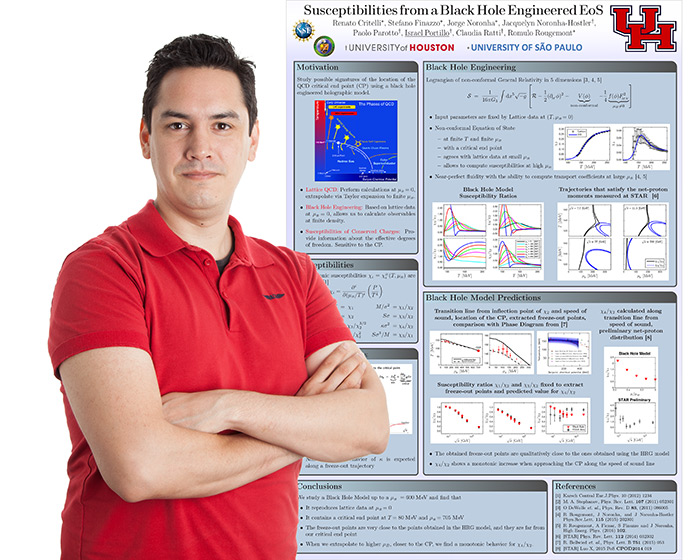Ph.D Student in Physics Wins Quark Matter 2017 Poster Contest
Invited to Give Plenary Talk
Israel Portillo, a Ph.D. student in the University of Houston’s Department of Physics, won a highly selective conference-wide poster contest at Quark Matter 2017 in Chicago. This conference, which brings together theoretical and experimental physicists from around the world, focuses on new developments in high energy heavy ion physics.
 Israel Portillo, a Ph.D. student in physics, won a conference-wide poster contest at Quark Matter 2017.Portillo’s poster, titled "Susceptibilities from a black hole engineered equation of state," was one of eight selected out of 400. Along with this honor, Portillo was invited to give a plenary talk at the end of the conference, where he presented his research findings in front of 800 conference attendees.
Israel Portillo, a Ph.D. student in physics, won a conference-wide poster contest at Quark Matter 2017.Portillo’s poster, titled "Susceptibilities from a black hole engineered equation of state," was one of eight selected out of 400. Along with this honor, Portillo was invited to give a plenary talk at the end of the conference, where he presented his research findings in front of 800 conference attendees.
Portillo’s research, which is in the area of nuclear physics, focuses on the transition between different states of matter.
“The nucleus of the atom is made up of protons and neutrons, which belong to a family of particles known as hadrons. Inside hadrons there are the fundamental constituents of matter, quarks and gluons,” Portillo said. Portillo, who started in the graduate program in 2014, is mentored by Claudia Ratti, assistant professor of physics in the College of Natural Sciences and Mathematics.
Portillo’s research models the transition from hadrons, which make up the nuclei of atoms, into a state of matter known as quark-gluon plasma.
“Theory predicts that if you have very high temperatures and densities, then these hadrons will melt to form a new state of matter known as quark-gluon plasma,” Portillo said. “The opposite transition happened at the beginning of the universe. A few microseconds after the Big Bang, the whole universe was in a state of quark-gluon plasma, then it expanded to form hadrons.”
Understanding the conditions at which hadrons transition into quark-gluon plasma can offer insight into the conditions just after the Big Bang, as well as the evolution of the universe.
Currently, the transition from hadrons to quark-gluon plasma can be recreated in relativistic heavy ion colliders, such as the one at Brookhaven National Laboratory (BNL) or at CERN. It can also be calculated at zero density by performing numerical simulations, which run on the most powerful supercomputers in the world. At higher densities, these simulations cannot be performed at the moment. Portillo’s research focuses on finding new methods to understand the transition at high densities.
In particular, Portillo's research group is using string theory-based techniques, which mimic the behavior of the quark-gluon plasma, to make predictions which can be experimentally verified at the particle collider at BNL.
“When we compare our model’s predictions to experimental results, these predictions show a high degree of agreement,” Portillo said. “Our results will help answer one of the main challenges in heavy ion physics, namely whether the transition between hadrons and the quark-gluon plasma at high densities is discontinuous.”
- Rachel Fairbank, College of Natural Sciences and Mathematics
May 2, 2017